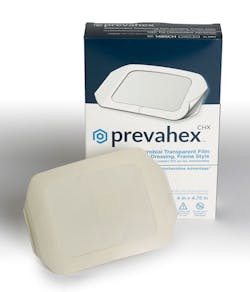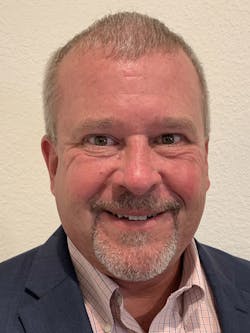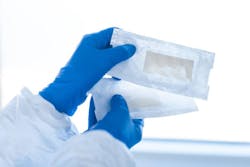Pandemic elevates concerns for skin, wound care
Caring for patient wounds and skin is critical. Skin and wounds need to be carefully treated as they are prone to irritation, dryness, exposure to potentially deadly microorganisms, as well as the development of possibly fatal pressure, amputation and other injuries. Additionally, COVID-19 poses unique patient health conditions and healthcare worker skin challenges.
Hospital and healthcare teams aim to provide specialized care, attention and products to treat wounds, cleanse skin, aid healing and prevent cross-contamination, infections and injuries. This care can improve patient comfort, saves patient lives and support facility costs.
Surgical site protection
Surgical incisions and other wounds require adequate barrier to benefit safety and healing, points out Melanie Waddell, Vice President Marketing, entrotech life sciences, inc.
“It’s important that any wounds, specifically post-surgical wounds, are protected to help prevent infections from occurring at the site,” Waddell emphasized. “Surgical site infections are very costly to hospitals and healthcare facilities and have considerable negative impacts to the patient. In addition, any products used to help protect that site should also support the wound healing process.”
“A vascular surgeon in Ohio has been using PrevahexCHX as a post-operative dressing for vascular patients,” she added. “He uses this dressing on his patients because of the Chlorhexidine antimicrobial component of this dressing to decrease the skin flora in the incisional area as the incision is commencing the healing process. In addition, there has not been any report of skin irritation, infection or rejection from any of the patients, and there has been overall acceptance of using this technology from the surgical and nursing staff.”
“ConvaTec’s AQUACEL dressings with Hydrofiber Technology provide advanced exudate management: they wick and lock exudate within the dressing,” Rian shared. “AQUACEL Dressings protect the wound bed, lower the risk of peri-wound maceration, reduce wound pain and dressing change pain, and maintain a moist wound environment conducive to wound healing. The AQUACEL Ag Advantage dressing addresses wound bioburden and infection, killing a broad spectrum of bacteria within the dressing, including antibiotic-resistant microorganisms, and has sustained antimicrobial activity in the dressing for up to seven days, preventing microbial reformation.”
Complicated wounds and care
What kinds of challenges happen with wounds that are ongoing or have trouble healing?
Ralph Lombardo, Senior Vice President of Sales & Marketing, and Director, Clinical Program, Avadim Health, Inc., calls out the complications with chronic and non-healing wounds, antibiotic use and microbial resistance.
“Chronic and non-healing wounds oftentimes are refractory to traditional treatment,” Lombardo explained. “These wounds are commonly challenged with biofilm bacterial colonization and have over-expressed inflammation. Eradication of this biofilm and control of this inflammation can be very difficult to achieve without the use of long courses of systemic antibiotics. While topical treatments can be effective, they also can interfere with epithelialization.”
“Microbial resistance is an additional challenge leading to fewer options, which jeopardizes clinical outcomes,” he added. “Unresolved wounds can increase hospitalization time and decrease patient comfort, which account for patient dissatisfaction and can impact a hospital’s ability to be reimbursed in Medicare/Medicaid’s Hospital Value-Based Purchasing programs.”
Hygiene and wound cleansing products, like Theraworx Protect, can be used to cleanse skin and decrease infection risk, notes Lombardo.
“Theraworx Protect has been proven safe for the stratum corneum, mucosa, face and perineum, including deep wounds,” he continued. “As a proven, non-inferior bathing alternative to standard ICU bathing, it supports antimicrobial stewardship programs. Plus, unlike other hygiene and wound cleansing products that can cause dryness and break down the skin’s barrier— increasing the risk of infection—Theraworx Protect is actually good for the skin, supporting the skin’s natural antimicrobial barrier and defensive functions. Its no-rinse, non-irritating formulation has no sticky residue leading to its inclusion in clinical bundles indicated to prevent hospital-associated infections.”
Other skin cleansers, non-antimicrobial dressings and bathing gloves can aid in bathing and protection of skin to lower infection risk, explains Tony Forsberg, RN, BSBA, WCC, CSPHA, National Clinical Director, Essity HMS North America Inc.
“Cutimed Sorbact dressings, with DACC technology, provide clinicians a lower-cost and effective treatment for all stages of wounds. Ease of use and atraumatic removal may help increase patient satisfaction. Sorbact dressings are an excellent alternative to antimicrobial dressings and work via a physical mechanism of action, immediately and irreversibly binding hydrophobic microorganisms, including bacteria,” Gray added.
Wounds commonly lead to amputations, which are hazardous and life-threatening, stresses Fertram Sigurjonsson, founder, president and CEO of Kerecis.
“Wounds are a major cause of amputations in the U.S., where more than 100,000 amputations are performed annually,” Sigurjonsson reported. “The 1.2 million amputees living here have a five-year survival rate of less than 30 percent, a rate similar to lung cancer. Even if an amputation is not needed, a chronic wound needs ongoing medical attention, which increases the cost of treatment and decreases the patient’s quality of life.”
Fish-skin grafts, like Omega3 Wound, can be used to help quicken healing and decrease chances for amputations or infections, explains Sigurjonsson.
“Quality wound care can speed healing, reducing the need for amputation, improving lives and lowering costs because fewer treatments are needed,” he said. An example is Dennis Reneau, a former U.S. Marine and top U.S. body builder who faced having both his feet amputated. Kerecis Omega3 Wound saved Dennis from a double amputation and gave him his former life back.”
“Clinical studies have found that Kerecis Omega3 Wound heals wounds faster, with fewer infections, than the standard of care,” Sigurjonsson added. “For example, an independent comparative study conducted by The Institut Curie, Henri-Mondor Hospital, Paris-Est University and University PSL found that patients treated with the Kerecis products healed in an average of 32 days, compared to 68 days for patients treated with standard treatment. The Kerecis patients experienced less pain and fewer infections. Also, the U.S. Office of Naval Research found that wounds treated with the Kerecis products were much more resistant to staphylococcus infections than wounds treated with competing products.”
Skin health amid COVID-19
COVID-19 remains a health concern for everyone. In addition to life-threatening infections, it also can cause skin issues for healthcare workers and additional health problems for infected patients.
“Irritation from PPE has been a common issue throughout this pandemic,” pointed out Essity’s Gray. “Clinicians could benefit by using a skin prep product under their masks. Hand sanitizers and disinfectants can dry out and irritate the skin. Dry skin can crack, which can become a portal of entry for bacteria. It is incredibly important to keep the skin hydrated with moisturizers. Essity’s Cutimed Protect has been an effective solution for this issue.”
Avadim Health, Inc.’s Lombardo agrees it is vital for healthcare staff to keep their skin, hands and faces clean and disinfected to help shield against contagious pathogens.
“When skin breakdown occurs under PPE, it can lead to more frequent touching or scratching of the broken skin and incorrect or premature removal of PPE, which gives viruses and bacteria the ability to penetrate the body and access the circulatory system,” he shared. “Theraworx Protect helps protect the hands and the face, particularly the T-zone (eyes, nose and mouth)—an area that leaves us most vulnerable to infection.”
For some COVID-19 patients, a rash may develop that is linked to the infection, describes Sigurjonsson of Kerecis.
“One unusual symptom of COVID-19 is a rash, which has been nicknamed “COVID toes,” he stated. “The red-purple, tender or itchy bumps develop mostly on the toes, heels and fingers. Although the jury is still out regarding the cause, many experts think that COVID toes may be one of the ways the body responds to the virus.”
What’s next in wound, skin care
As COVID-19 has sidelined or discouraged many people from seeking medical care, wound conditions may become more challenging to treat, notes Kerecis’ Sigurjonsson.
“We expect wound care to become a bigger issue because so many patients did not get treated during the pandemic,” Sigurjonsson said. “As a result, their wounds have become more serious and may require treatment in a hospital setting. It’s likely that hospitals will be able to treat only the most complex wounds, and that patients with less serious conditions will be treated elsewhere.”
ConvaTec Inc.’s Rian predicts advancements in wound and skin care applications that can help patients with challenging conditions to safely recover at home.
“Wound care treatment modalities and skin care products will continue to evolve, with new components, materials and innovations developed to more effectively manage complex, non-healing wounds,” she explained. “The full impact of the coronavirus pandemic remains to be seen, but the need to have advanced wound care dressings that can effectively manage the hard-to-heal wounds of patients cared for at home will likely intensify. With the increase in COVID-19 patients requiring critical care, along with proning these patients who develop Acute Respiratory Distress Syndrome, the use of dressings, such as AQUACEL Foam Pro, for skin protection from pressure injury will continue to be an important intervention.”
Greater knowledge of the skin’s make-up and restorative properties will be a concentration in the future of care, foresees Avadim Health, Inc.’s Lombardo.
“As we understand more about the role of the skin’s microbiome and the important role of antimicrobial peptides in infection prevention and skin and tissue restoration, we’re very close to having products on the market that can protect wounds from infection and biofilm formation and adherence, re-establish healthy inflammatory response and cellular renewal, and encourage tissue oxygenation – all in a way that’s safe and comfortable for the patient and healthcare providers,” Lombardo expressed.
Gray and Forsberg of Essity envision ongoing education about wound care and prevention, as well as wish for the equipment needed to safely care for patients.
“Obesity and other co-morbid conditions make caring for these patients challenging,” Gray said. “As nurses, we need to be vigilant when developing care plans. Hopefully, resources, such as lifts, transfer sheets, low air-loss surfaces, foams, breathable briefs, etc., will be readily available in all facilities.”
About the Author

Ebony Smith
Ebony Smith was previously Managing Editor for Healthcare Purchasing News.






